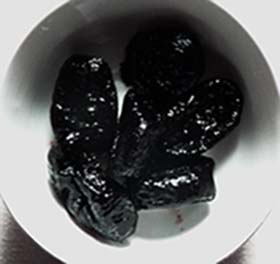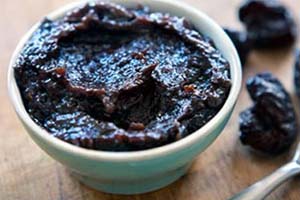Prunes (dried plums) Nutrition facts
Prunes are delicious dried fruits obtained after drying ripe plums. Not all the plum varieties can be dried to get good quality prunes. Certain high sugar content, freestone European cultivars such as "prune d'Aegen, and d'Ente are quite popular in the USA for plum production.
Botanically, plums belong to the "drupe" family (Rosaceae) of fruits, characterized by the hard pit (stone) surrounded by firm/soft pulp.
Scientific name: Prunus domestica. L
 |
| Pitted prunes |
Sacramento Valley in California produces most of the exported dried plums in the United States. The improved "French" cultivar is the most preferred type grown in the California valleys. They are characterized by their uniform maturity, high sugar content, fair heat tolerance, and ability to ripen fully on the tree without fermenting.
Plum is a medium-sized deciduous tree, growing about 3-4 meters tall in cultivated orchards. It produces mauve white flowers that subsequently develop into deep purple fruits, dusted with gray bloom, by August.
Today, most of the work related to securing good quality prunes is done with mechanical assistance, from harvesting to drying. Roughly, three pounds of fresh plums yield one pound of prunes.
Being a "drupe" family fruit, dried plum features a single, hard, inedible pit.
8 Amazing Health Benefits of dried plums
Like in other dried fruits such as dates, raisins, and goji berry, dried plums are concentrated sources of antioxidants, energy, minerals, vitamins, and fiber.
Prunes are an excellent source of soluble dietary fiber, sorbitol, and isatin. These compounds have been known to help smooth digestion and offer comfort from constipation problems. In traditional medicine, soaked prunes are consumed as a laxative.
They also provide about 50% RDA levels of vitamin K per 100 g. Vitamin K is essential for the smooth functioning of many clotting factors in the blood. It is also required for bone metabolism. Also, this vitamin helps limit neuronal damage in Alzheimer's disease patients.
Dried plums are an excellent source of vitamin-A and β-carotene. 100 grams carry 789 IU of vitamin A. This vitamin is essential for good eyesight. It is also required for maintaining healthy mucosa and skin. Consumption of fruits naturally rich in vitamin A has been found to protect from lung and oral cavity cancers.
Likewise as in fresh plums, prunes too carry health-promoting flavonoid polyphenolic antioxidants such as lutein, cryptoxanthin, and zeaxanthin in significant amounts.
These compounds help act as scavengers against oxygen-derived free radicals and reactive oxygen species (ROS) that play a role in aging and various disease processes. Zeaxanthin, an important dietary carotenoid selectively absorbed into the retinal macula lutea where it is thought to provide antioxidant and protective UV light-filtering functions.
Prunes are a concentrated source of minerals like potassium, copper, manganese, and iron. Iron is required for red blood cell formation. Potassium is an important component of cells and body fluids that helps control heart rate and blood pressure.
Further, they are good sources of B-complex groups of vitamins such as riboflavin, niacin, pyridoxine, and pantothenic acid. These vitamins act as cofactors to help the body metabolize carbohydrates, protein, and fats.
| Principle | Nutrient Value | Percent of RDA |
|---|---|---|
| Energy | 240 Kcal | 12% |
| Carbohydrates | 38.13 g | 29% |
| Protein | 2.18 g | 1.2% |
| Total Fat | 0.38 g | 2% |
| Cholesterol | 0 mg | 0% |
| Dietary Fiber | 7.1 g | 19% |
| Vitamins | ||
| Folates | 4 µg | 1% |
| Niacin | 1.882 mg | 12% |
| Pantothenic acid | 0.442 mg | 8% |
| Pyridoxine | 0.205 mg | 16% |
| Riboflavin | 0.026 mg | 16% |
| Thiamin | 0.051 mg | 4% |
| Vitamin A | 781 IU | 26% |
| Vitamin C | 0.6 mg | 1% |
| Vitamin E | 0.43 mg | 3% |
| Vitamin K | 59.5 µg | 50% |
| Electrolytes | ||
| Sodium | 2 mg | 0% |
| Potassium | 732 mg | 19% |
| Minerals | ||
| Calcium | 43 mg | 4% |
| Copper | 0.281 mg | 31% |
| Iron | 0.93 mg | 9% |
| Magnesium | 41 mg | 10% |
| Manganese | 0.299 mg | 13% |
| Phosphorus | 69 mg | 10% |
| Selenium | 0.3 µg | <1% |
| Zinc | 0.44 mg | 4% |
| Phyto-nutrients | ||
| Carotene-ß | 394 µg | -- |
| Crypto-xanthin-ß | 93 µg | -- |
| Lutein-zeaxanthin | 148 µg | -- |
Selection and storage
In the supermarkets, prunes can be available around the year in packs, and boxes/bins. Look for authentic produce before purchase. Buy uniform, good (ink black) color, fairly firm to a slightly soft stage of ripeness prunes.
Although bleaching using sulfur gas is not in practice now, avoid any sulfur gas-treated prunes. As a general modern industry practice, potassium sorbate solution may be used to inhibit yeast and mold on prunes.
Dry plums can be stored at room temperature for a few days. Inside the refrigerator, they can last for a couple of weeks.
Preparation and serving method
Dried plums can be eaten as is. Immersing them in hot water makes them soft and plump as in raisins.
Here are some serving tips:
 |
| Pureed prunes |
Prunes can be enjoyed as is; as delicious snacks.
They can be pureed and preserved for several months inside the refrigerator. They are being used in the preparation of pies, desserts, jams, and jellies.
Add them to cooking dishes, poultry, lamb, and rice pilaf.
Prunes are also fond of in the confectionary. They can be added to muffins, bread, trifle, cakes, cookies, etc.
Safety profile
Prunes can be safely consumed by all, including children and pregnant women. People allergic to potassium sorbate may want to avoid them in food.
Plums carry oxalic acid, a naturally occurring substance found in some fruits and vegetables, which may crystallize as oxalate stones in the urinary tract in some people. people with known oxalate urinary tract stones are encouraged to avoid eating plums. Adequate intake of water is advised to maintain normal urine output even if these persons want to eat them. (Medical disclaimer).
≺≺-You may also like to read- Plums nutrition facts and health benefits
≺≺-Back to Fruits from Prunes nutrition. Visit here for an impressive list of all varieties of fruits with complete illustrations of their nutrition facts and health benefits.
≺≺-Back to Home page.
Further reading and Resources:
Stanford School of Medicine Cancer information Page- Nutrition to Reduce Cancer Risk.